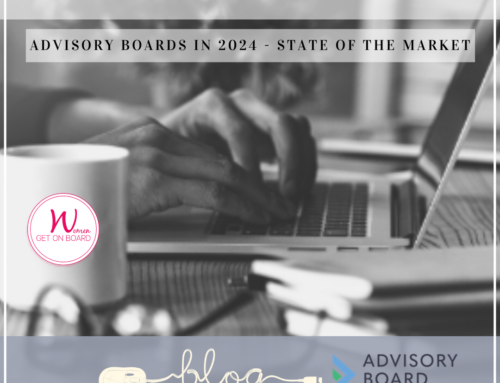In recent years, significant strides have been made to improve board diversity in public companies in Canada. However, as many board leaders will attest, there is still a long way to go to reach gender parity in Canadian boardrooms.
The 2023 Diversity Disclosure Practices Report from Osler Hoskin & Harcourt LLP reflects this reality. Their ninth annual comprehensive report, which covers diversity disclosures by TSX-listed companies and CBCA corporations subject to disclosure requirements, analyzes year-over-year trends across various industries, spotlighting success stories and areas of opportunity.
To examine the report in detail, Women Get On Board Inc. (WGOB) hosted a virtual Speaker Series event on November 21, 2023 titled Board Diversity Matters. The event included an analysis of the highlights from the Osler 2023 Diversity Disclosure Practices Report, followed by a panel discussion on the topic featuring leading and serving corporate directors.
The state of board diversity in 2023
Deborah Rosati, FCPA, FCA, ICD.D, GCB.D, CCB.D, Corporate Director and WGOB Founder and CEO, opened the virtual event by introducing Andrew MacDougall, Partner at Osler, Hoskin & Harcourt LLP to provide an overview of the report’s findings.
“Our goal with our annual report has always been to provide companies with inspiration and the tools that they need to do more in terms of improving diversity within their organization,” said Andrew.
Their analysis shows that gender diversity within the leadership in corporate Canada is improving. The proportion of women on Canadian boards and in executive officer positions is increasing, with women now holding close to 30% of all board seats at TSX-listed companies. Not only that, but a woman was chosen to fill vacant or newly created board positions 45.3% of the time over the past year—a sign that Canadian companies are nearing the rate at which boards could, over time, achieve gender parity.
However, not all measures of diversity are improving. While more members of visible minorities are sitting on boards and in C-suites than ever before (10.2% of board seats among CBCA corporations, compared to 8.3% last year), that number is nowhere close to the proportion of the Canadian population that is a member of a visible minority (27%). Meanwhile, representation of Indigenous peoples and persons with disabilities has seen virtually no progress. Indigenous people hold less than one percent of board positions when they represent 5% of the population, and persons with disabilities hold 0.7% of positions, when they make up 22% of the population.
“We still have a great deal of progress that needs to happen with respect to these other diversity characteristics,” said Andrew.
How long will it take for boards to reach gender parity?
Following his analysis, Andrew introduced the two panelists, Wendy Kei, Board Chair at Ontario Power Generation & NFI Group Inc. (TSX: NFI, OTC: NFYEF; TSX: NFI.DB) and Michelle Banik, Director of Empire Company Limited (TSX: EMP,A) to discuss the results of the report.
Off the top, Andrew asked the panel for their thoughts on gender diversity in the boardroom. How long do they think it will take for all boards to reach gender parity?
“I think it will take more than 10 years,” said Wendy. “I think if there is not a push from regulatory bodies, stakeholders and shareholders, I think getting to parity is going to be difficult.”
She pointed to Norway as a prime example. The country mandated 40% of members be women back in 2008. Now, 15 years later, Norwegian companies have not yet reached gender parity.
Michelle agreed, noting problems in the talent pipeline as one of the issues preventing parity in the boardroom. With the rates of women in executive positions in Canada remaining stagnant, there won’t be enough women positioned to take on board roles over the next decade.
What role should diversity targets play?
With women now holding close to 30% of all board seats at TSX-listed companies, which was once considered a key target for gender diversity advocates, it’s necessary to explore the topic of targets. Are they still a key piece of the puzzle for reaching gender parity?
Both panelists were in favour of continuing to set more ambitious targets as a tactic for pushing companies to improve gender diversity in the boardroom.
“I like the approach taken by the UK,” said Michelle. “If companies are truly dedicated to increasing the representation of women on boards, a target of 40% shouldn’t be difficult to reach.”
Wendy mentioned that the current “comply and explain” guidelines simply do not move the needle fast enough. By establishing targets, companies are required to not only to bring in more women candidates, but also to work proactively to solve the current pipeline problems.
To illustrate the importance of getting more women into the boardroom, Wendy shared anecdotes from her own board experiences. She currently serves on multiple boards that have reached or exceeded gender parity. However, in the past she has also been the first and only woman member on various boards for TSX-listed companies. She said the experiences were completely different.
“Being the first female on a publicly-traded board is difficult,” she said. “You are often hitting your head against the wall. You’re often trying to push the governance standards and getting pushback. But having a second female, a third female changes the dynamic in that boardroom.”
What can women do to advance their board careers in Canada?
Andrew asked the panelists to speak more about their board experiences and offer advice for serving and aspiring woman corporate directors in Canada.
Michelle had a few key pieces of advice to share with women. First, it’s vital to hold a genuine interest in contributing to the success of the companies and boards you serve. Second, you should be able to articulate the value you bring and have the confidence to demonstrate it. And finally, it’s critical to invest in your professional development as a director, both in terms of governance skills and knowledge on relevant issues.
Wendy recommended finding a mentor to guide you on your board journey. Mentors can help by listening, helping you understand your role, and offering advice on next steps. She also recommended that candidates work to understand their personal EQ, and how it will impact your ability to succeed on a board.
The changing board diversity landscape
As part of their conversation, the panelists discussed how views around diversity in the boardroom have changed in the past few years. Andrew noted that companies are moving away from the expectation that all board members must have experience as a CEO, a shift that benefits women candidates, as there are still so few women CEOs in Canada. Now, boards have the latitude to recruit women directors with specialized skills in other fields such as law, finance, HR, and tech.
Many boards are also adopting new practices designed to address gender diversity directly. The primary tools in use are written board governance documents, such as policies and skills matrices. In fact, Andrew’s team at Osler worked with the Insititute of Corporate Directors to develop a customizable board diversity policy tool for Canadian companies.
“Why did we do that?” said Andrew. “Well, with a board diversity policy, you can have a conversation at the board level on something concrete.”
He noted that when you move beyond a basic discussion and instead prepare a written, actionable document, you tend to generate a more thoughtful approach to the topic.
Wendy raised the topic of term limits and age limits, noting that they are a key tool for improving gender diversity. She also discussed the possibility of lowering the barriers for candidates by cutting down on the “must have” requirements for new directors. Instead, companies could commit to filling skill and knowledge gaps by investing in board education.
“The right candidate might not tick all of the boxes, but as a company we need to get them there,” she said.
In conclusion
As Osler’s 2023 Diversity Disclosure Practices Report shows, gender diversity in the boardroom is gradually improving. However, to reach gender parity in the next decade, companies must take serious, intentional measures to recruit women directors. By adopting more ambitious diversity targets, building a pipeline of experienced women candidates, and considering other practices such a dedicated board diversity policy or age and term limits, companies can accelerate their progress towards bringing more women into the boardroom.





